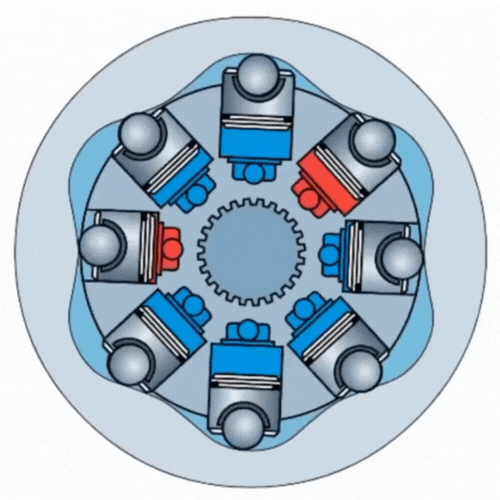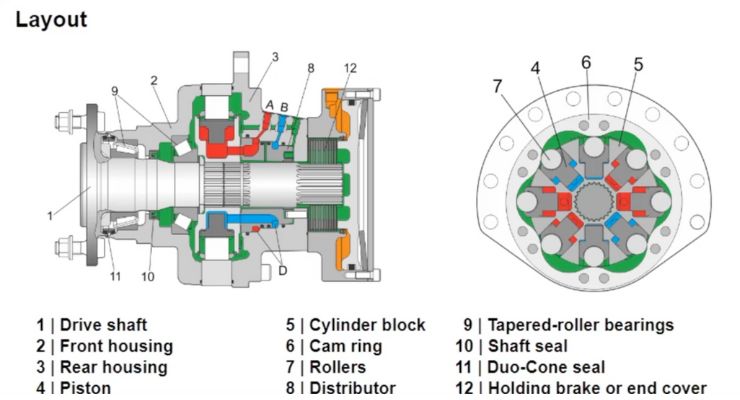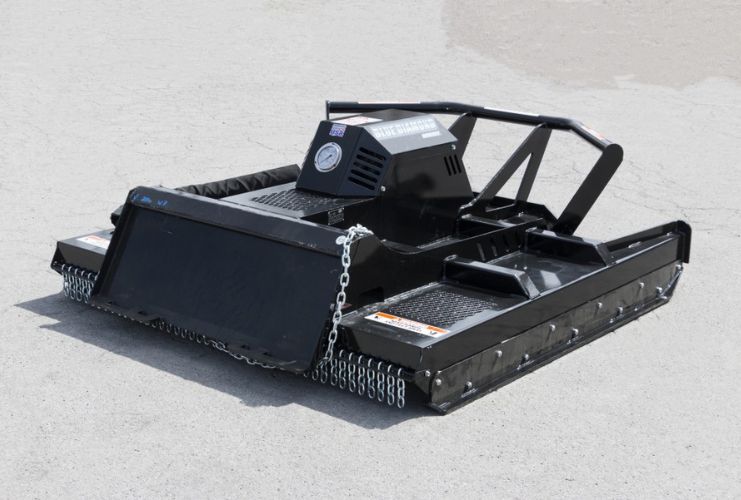
Radial Piston Skid Steer Brush Cutter Motor - Explained
Share
With all of our talk of how impressive radial piston motors are when used to power skid steer brush cutter attachments, we thought we should answer your next question... How do radial piston motors work?
Key Take Aways
- A radial piston motor has pistons arranged in a star formation around the output shaft.
- On the end of each piston is a roller that allows the piston to travel around an eccentric cam ring.
- Hydraulic pressure pushes the piston against the eccentric cam ring, the lobes in the cam ring push the piston back, causing rotation force to occur.
What is a Radial Piston Motor?

As an introduction, radial piston motors is a type of hydraulic motor that is commonly used to power machinery such as forklifts, skid steers and excavators. It is often used as a "direct drive" motor, not needing reduction gears, and can be bolted directly to travel components.
The fact that it is used in conditions that require high power is not a coincidence. By design, radial piston motors supply high torque, low speed, smooth function and have a longer service life than other common hydraulic motors when used and maintained properly.
How Does a Radial Piston Motor Work?
There are two main components that need to be understood when discussing how a radial piston motor works. One is the the eccentric cam ring, and the other is the pistons themselves.

Eccentric Cam Ring
An eccentric cam ring is a ring that is fastened internally around the inside of the motors housing which the pistons push against in order to supply torque and rotation to the output shaft.
The trick to the radial piston motor working is the fact that the cam ring is "eccentric". This means that instead of the ring having a uniform shape, it has lobes and valleys built into it. This is an important consideration as we will discuss later.
Radial Pistons
As the name implies, a radial piston motor has pistons arranged in a "ray" around the output shaft. You can also think of these pistons as being arranged in a star formation, with one end attached to the output shaft, and the other end in contact with the eccentric cam ring.
On the end of the piston is a "roller" which allows the piston to travel along the cam ring, which as you'll see, is key to the radial piston motors operation.
How Do They Work Together?

Pressurized hydraulic oil is sent from your skid steer to your brush cutters radial piston motor. The oil is used to pressurize the pistons as they are travelling down the cam ring lobes. The piston, with it's roller pushing against the cam lobe is what creates the rotational force.
As the piston reaches the bottom of the valley in the cam ring, it will no longer be receiving pressurized oil. As the piston is pushed back up the next cam lobe it will return the oil within its cylinder to the return line.
Once the piston is on its way back down the next cam lobe, it will once again be receiving pressurized oil and pushing against the cam ring to add more rotational force. In the end, every time a piston is rolling down a cam lobe, it is pressurizing and providing rotational torque.
Much like other types of piston engines, a radial piston motor will have more than piston applying power at a time. This ensures that continuous power is applied through out the entire rotation of the drive shaft.
Check Out This Video Below From The "Rotary Power" Youtube Channel For A Video Of This In Action.
Other Brush Cutter Motor Components
Your brush cutters radial piston motor will be accompanied with a distributor and manifold block that regulates and controls the pressure of the hydraulic fluid entering and exiting the hydraulic motor.
Brush cutters with radial piston motors will often require a case drain line. This relieves excess hydraulic pressure from the motor and is vitally important.
If your skid steer brush cutters motor requires a case drain line, even using the brush cutter momentarily without the case drain will certainly damage the motor and void your warranty. Check with the manufacturers recommendations.
As with any hydraulic motor, there will be several bearing assemblies to allow moving parts to rotate freely. Seals on both ends of the motor are used to keep lubrication in the motor and dust and dirt out.
Radial Piston Brush Cutter Motors - Other Considerations

It is vitally important to keep the hydraulic fluid clean when using any radial piston motor. Pistons inside the motor are manufactured to tight tolerances, and any amount of dirt or debris will quickly comprise the motor.
Brush cutters in particular tend to throw dust dirt and debris every which way. A best practise is to ensure that that the hydraulic couplers are perfectly clean before connecting or disconnecting them to your skid steer.
Common Radial Piston Motor Specifications
-
Radial piston motors are commonly built in 150cc to 3000cc displacements, however, when used in skid steer brush cutter applications, 150cc to 250cc is normal.
-
Radial Piston Motors are normally designed with a maximum 100 to 900 revolutions per minute. When used with a skid steer brush cutter, the RPM will be on the lower end of this range.
Conclusion
Radial piston motors are the perfect way to power your skid steer brush cutter. With its simple direct drive, low speed, high torque capabilities, it is an obvious choice for Severe Duty Brush Cutters.
If you want to discuss further on how these motors work, or any other skid steer hydraulic motor, feel free to reach out to the author directly using the links provided.

